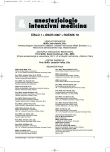Intramuscular suxamethonium in experiment and in clinical practice
Authors:
M. Svítek 1; L. Hess 2; V. Rogozov 2; J. Schreiberová 3
Authors‘ workplace:
Klinika anesteziologie, resuscitace a intenzivní medicíny, UK 1. LF a Všeobecné fakultné nemocnice, Praha
1; IKEM, Praha
2; Klinika anesteziologie, resuscitace a intenzivní medicíny, Fakultní nemocnice Hradec Králové
3
Published in:
Anest. intenziv. Med., 18, 2007, č. 1, s. 35-39
Category:
Anaesthesiology - Original Paper
Overview
Objective:
To assess if intramuscular suxamethonium 0.5 mg . kg⁻¹ administered to cats during general anaesthesia results in immobilisation without disturbance of spontaneous breathing. To assess optimal dose of intramuscular suxamethonium in adult humans.
Design:
Prospective experimental study in cats, prospective clinical study in humans.
Materials and methods:
Suxamethonium 0.5 mg . kg⁻¹ was administered in the hind paw of cats anaesthetised with a medetomidine-ketamine combination. Muscle relaxation was measured using accelerograph TOF Watch SX and cardiorespiratory monitoring was performed by pulse oximetry. A pilot study was performed in humans to assess the optimal suxamethonium dose. The main study was performed in 10 patients ASA 1–2. Suxamethonium 3 mg . kg⁻¹ was administered in the deltoid muscle. The depth of muscle relaxation was measured by TOF Watch SX, the conditions for tracheal intubation were assessed by an accompanied scale.
Results:
Suxamethonium 0.5 mg . kg⁻¹ administered to cats resulted in immobilisation with preserved spontaneous ventilation. In adult humans, good conditions for tracheal intubation were achieved 3–3.5 minutes after intramuscular suxamethonium 3 mg . kg⁻¹.
Conclusion:
Immobilisation with preserved spontaneous breathing in cats can be achieved with intramuscular suxamethonium, but the therapeutic range is low. Intramuscular suxamethonium can be used for emergency tracheal intubation not only in children but also in adults.
Keywords:
suxamethonium – animal immobilization – intramuscular administration – use in adults
Labels
Anaesthesiology, Resuscitation and Inten Intensive Care MedicineArticle was published in
Anaesthesiology and Intensive Care Medicine

2007 Issue 1
Most read in this issue
- The American Society of Anesthesiologists’ (ASA) Classification of Physical Status – time for change?
- Lev Spinadel – founder of anaesthesiology in Czechoslovakia
- Incidence of postoperative residual curarization following cisatracurium and rocuronium-induced neuromuscular block: a prospective study
- Early urine and blood biochemical changes in experimental model of sepsis
